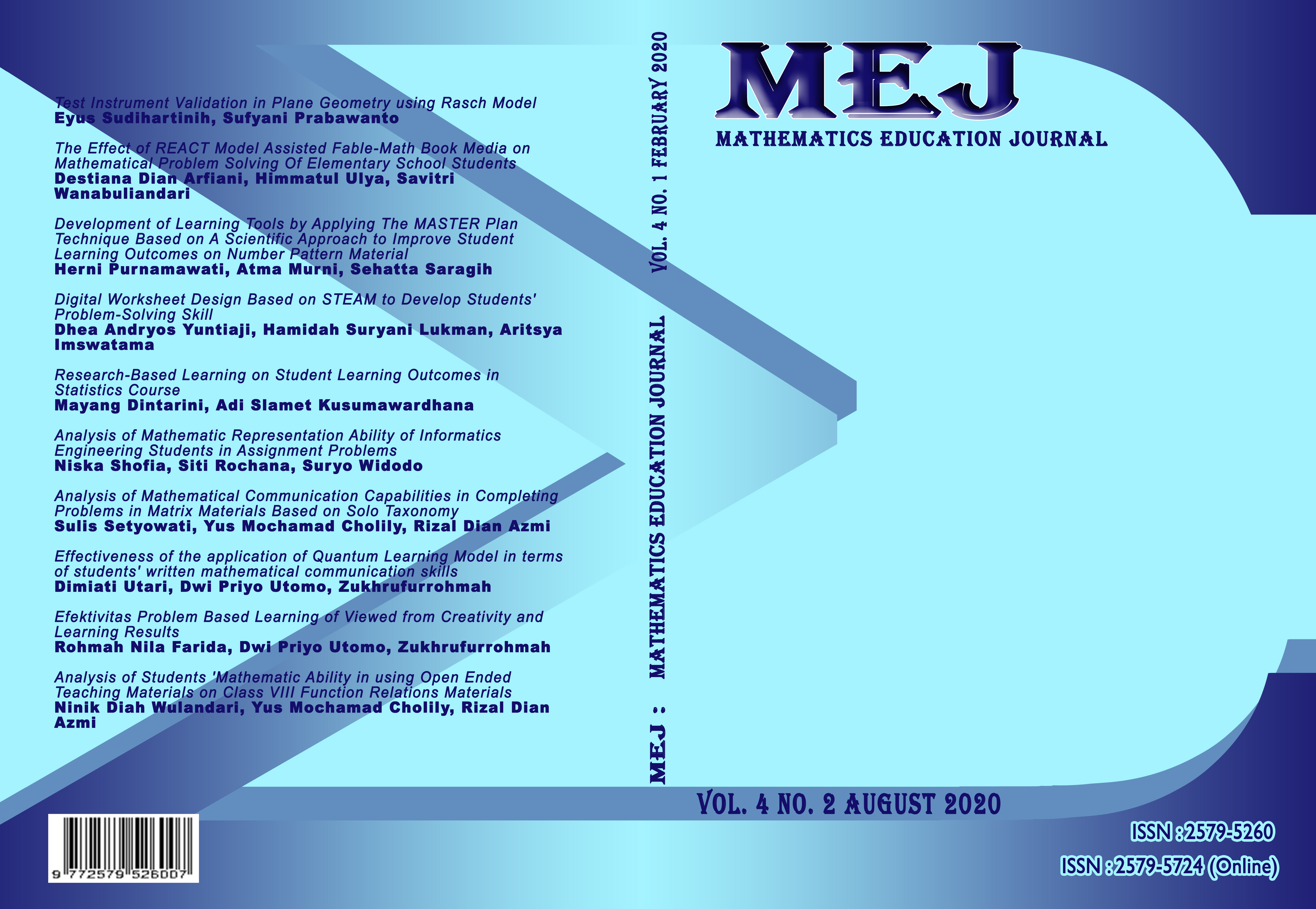Analysis of Students 'Mathematic Ability in Using Open Ended Teaching Materials on Class VII Function Relations Materials
DOI:
https://doi.org/10.22219/mej.v4i2.12834Keywords:
mathematical communication skills, open ended based teaching materials, relationships and functionsAbstract
This study aims to describe students' written mathematical communication skills in using open ended-based teaching materials on class VIII function relations material. The type of research used is descriptive qualitative. The research subjects were 5 students of class VIII E, SMP Negeri 12 Malang. Data collection techniques in this study in the form of tests and interviews. Research results obtained by students in the category of high mathematical communication skills have the ability to convert questions into set notations, students are quite capable of transforming mathematical information into images and students are able to use mathematical information to solve problems. Students with written mathematical communication skills are having sufficient ability to convert mathematical information into the form of set notations, students are less able to convert mathematical information into images and students are able to use mathematical information to solve problems. Students with low communication skills seen from students are not able to change the questions into set notations, students are less able to convert mathematical information into images and students are unable to be less able to use mathematical information to solve problems.Downloads
References
Dina, A., Mawarsari, VD, & Suprapto, R. (2015). Implementation of 2013 Curriculum on Learning Tools Discovery Learning Model Scientific Approach to Mathematical Communication Capabilities of Vocational Geometry Materials. Journal of Mathematics Education Work, 2 (1). Retrieved from https://jurnal.unimus.ac.id/index.php/JPMat/article/view/1830 Ferdiani, RD (2015). Two Stay Two Stray Learning to Improve Mathematical Communication on Material Relations and Functions in Al Inayah Purwosari Pasuruan Middle School. Journal of Educational Inspirations, 5 (2), 715-721. https://doi.org/10.1017/CBO9781107415324.004 Hidayanto, T., & Irawan, E. (2013). Development of Mathematic Education Realistic Based Learning Materials To Build Mathematical Communication Capabilities of Grade VIII Middle School Students on Function Material. Malang State University, 13 (3), 2. Jasmaniah, Fachrurazi, & Yeni, EM (2015). Open-ended Problem Solving Based Learning Materials in Mathematics Learning to Develop Students' Reasoning Ability in PGsd. Journal of Educational Research, 15 (3). Kadarisma, G. (2018). Application of Open-Ended Approach in Improving Communication Capabilities of Middle School Students. Scientific Journal of Mathematics Education, 1 (2). Melati, RS, Purwasi, LA, & Fitriyana, N. (2019). Development of Student Worksheets Based on the Open Ended Approach on the Relationship Materials and Functions of Class VIII Students of SMP Negeri 2 Lubuklinggau in the 2018/2019 Academic Year. Concept and Communication, null (23), 301-316. https://doi.org/10.15797/concom.2019..23.009 Sari, DP, Nurochmah, N., Haryadi, H., & Syaiturjim, S. (2016). Improving the Ability of Mathematical Understanding Through the Student Teams Achivement Division Learning Approach. Journal of Mathematics Education Research, 3 (1), 16. https://doi.org/10.21831/jrpm.v3i1.7547 Subekti, S. (2016). Comparative Effectiveness of Open-Ended and GI Approaches Judging from Communication, Mathematical Problem Solving and Learning Motivation. Pythagoras: Journal of Mathematics Education, 8 (2), 204–212. https://doi.org/10.21831/pg.v8i2.8950 Sugiyono (2015). Quantitative, Qualitative, and R&D Research Methods. Bandung: Alfabeta. Umar, W. (2012). Building Mathematical Communication Skills in Mathematics Learning. Infinity Journal, 1 (1), 1. https://doi.org/10.22460/infinity.v1i1.2 Yanti, RN, Melati, AS, & Zanty, LS (2019). Analysis of Understanding Ability and Mathematical Communication Skills of Junior High School Students in Material Relations and Functions. 3 (1), 209-219.
Downloads
Published
Issue
Section
License
Authors who publish with MEJ (Mathematics Education Journal) agree to the following terms:
For all articles published in MEJ, copyright is retained by the authors. Authors give permission to the publisher to announce the work with conditions. When the manuscript is accepted for publication, the authors agree to automatic transfer of the publishing right to the publisher.
Authors retain copyright and grant the journal right of first publication with the work simultaneously licensed under a Creative Commons Attribution-ShareAlike 4.0 International License that allows others to share the work with an acknowledgment of the work's authorship and initial publication in this journal.
Authors are able to enter into separate, additional contractual arrangements for the non-exclusive distribution of the journal's published version of the work (e.g., post it to an institutional repository or publish it in a book), with an acknowledgment of its initial publication in this journal.
Authors are permitted and encouraged to post their work online (e.g., in institutional repositories or on their website) prior to and during the submission process, as it can lead to productive exchanges, as well as earlier and greater citation of published work (See The Effect of Open Access).

This work is licensed under a Creative Commons Attribution-ShareAlike 4.0 International License.










